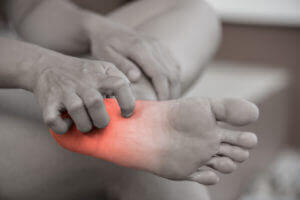
Thanks to all of the pressure placed on your feet when doing everything from walking and running to just sitting down in a chair, there are quite a number of things that can go wrong with your foot. If you have a foot problem that is causing pain, it is in your best interest to see a podiatrist.
Let’s talk about 10 of the most common types of foot problems, and where you can go here in northern New Jersey for outstanding podiatric medical care and treatment so you can get back to doing what you love to do.
#1: Corns and Calluses
Corns and calluses are raised patches of dead skin that form as a result of the skin protecting itself against friction. Corns tend to be small and perfectly round, whereas calluses are larger and can be in unusual shapes.
A common cause of corns and calluses is wearing tight shoes. Soaking your feet in warm water and filing down the corn or the callus can help it go away. If the problem persists, a podiatrist can remove the corn or the callus, or give you topical medications that will help it to disappear.
#2: Ingrown Toenails
An ingrown toenail is when the adjacent skin has grown over the edge of the nail. It can easily cause an infection in the area. If the problem persists or is painful, a skilled podiatrist can repair the nail so that it heals properly and is no longer attached to the skin.
#3: Athlete’s Foot
A type of fungal infection, athlete’s foot can cause itching, stinging, and burning skin between the toes. Athlete’s foot can especially develop from walking in a public or shared shower area or bathroom, where the constantly damp environment can encourage fungal growth. It is best to wear flip-flops when walking in a public restroom or using a public shower.
#4: Foot Blisters
Blisters are painful, fluid-filled pockets of skin that form because of ill-fitting shoes that rub against your skin. You may be tempted to pop a blister, but don’t – this could cause a foot infection. The blister will heal on its own as long as you stop wearing the problematic shoes.
#5: Bunions
Bunions are outward bumps that develop on the side of the foot at the base of the big toe. They form due to tight shoes that push the big toe inward, toward the second toe.
A bunion can cause tenderness and can limit your ability to walk or run comfortably. To avoid a worsening bunion problem, wear comfortable, supportive, cushioned shoes. If conservative (nonsurgical) treatments do not alleviate the foot pain and the resulting foot deformity, a podiatrist can perform outpatient surgery to correct the alignment.
#6: Plantar Fasciitis (and Heel Pain)
Plantar fasciitis is inflammation of the plantar fascia, which is the strong band of tissue that connects the toes to the heel. When this inflammation occurs, it radiates to the heel and causes heel pain.
Resting the foot, taking over-the-counter pain medication, and stretching the plantar fascia and the calf muscles can usually relieve symptoms of plantar fasciitis. Because having high arches or flat feet can make you particularly susceptible to developing plantar fasciitis, your podiatrist can fit you with custom orthotics to help prevent or relieve this condition.
Untreated plantar fasciitis can lead to the development of heel spurs.
#7: Heel Spurs
A heel spur is a bony growth that forms at the bottom of the heel bone. It is often a result of plantar fasciitis and the extra stress it places on the heel, which causes calcium deposits to develop in the part where the plantar fascia meets the heel bone. A podiatrist can give you a noninvasive treatment for your heel spur that can help the spur to disappear.
#8: Gout
Gout is a type of arthritis that causes intense pain and/or swelling of the big toe. It is caused by the buildup of uric acid, which tends to be especially due to a diet that is rich in seafood, red meat, and alcohol.
The best way to alleviate gout is by drinking plenty of water. If symptoms persist, topical medication provided by a podiatrist can help control your body’s production of uric acid.
#9: Morton’s Neuroma
Morton’s neuroma is when a mass of tissue forms around a nerve in the ball of your foot, usually between the third and fourth toes (starting with the big toe). It can cause a sensation that can be likened to having a pebble stuck in your shoe. It can cause pain, stinging, numbness, or burning.
Morton’s neuroma can develop and get worse from wearing high-heeled and pointy-toed shoes, and also from heavy running. Custom orthotics can help ease the pressure and relieve the symptoms.
#10: Warts
Warts can be in all shapes and sizes, including tiny warts on the bottom of your foot. Warts are caused by a virus, so they tend to go away and recur later. Your podiatrist can give you a special topical solution that can help to eliminate the wart so that it doesn’t continue to cause pain or discomfort when walking and standing.
Foot Doctor in North Jersey
The podiatrists at Hudson MD Group diagnose and treat patients with all manner of foot problems. To schedule an appointment with one of our outstanding podiatrists, call us today at (973) 705-4914 or fill out our online contact form now. We look forward to serving you!


